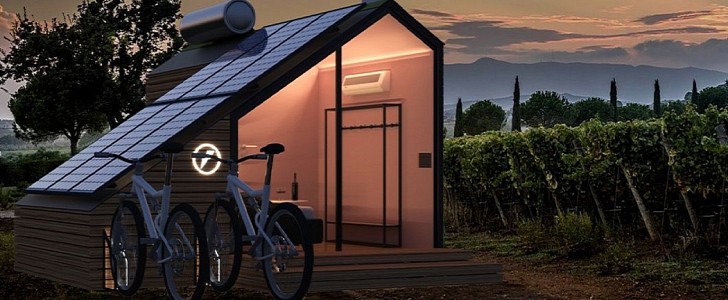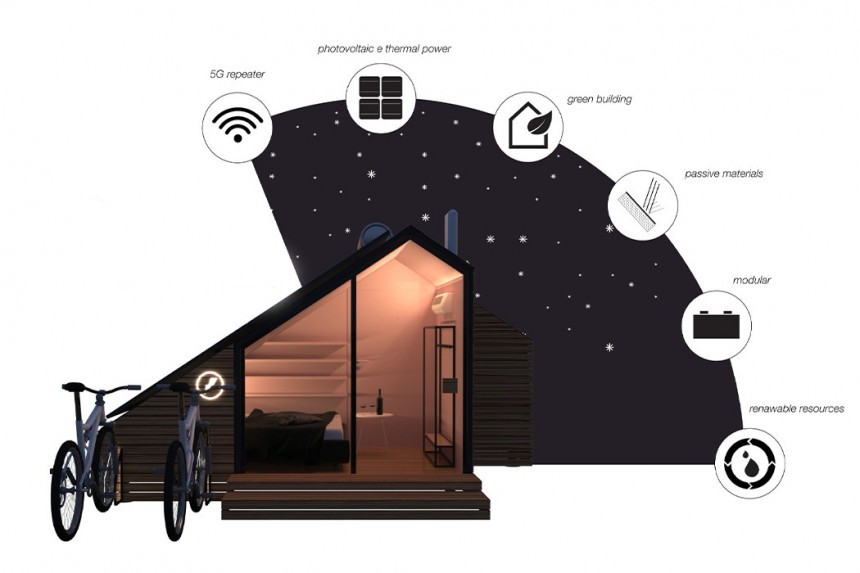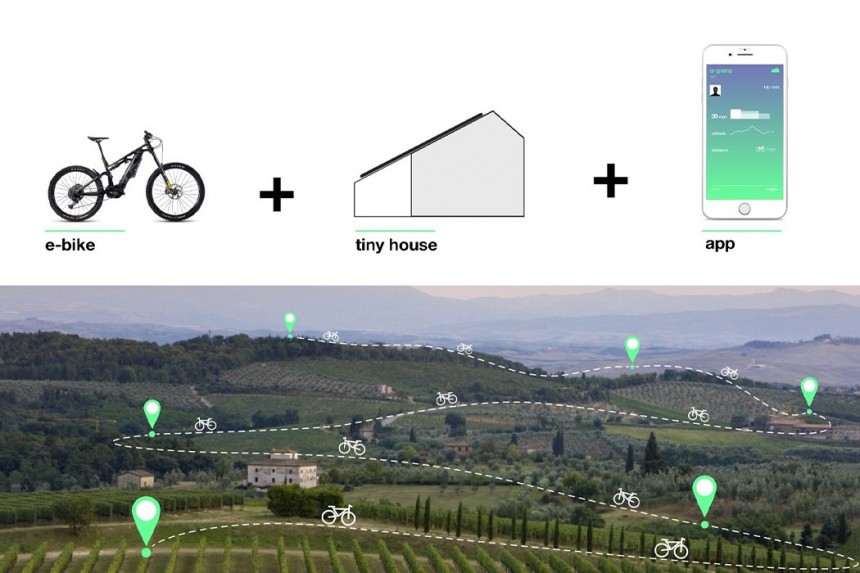The entire world dreams of the day when we’ll be able to get back to “normal” after the extended health crisis. This nominee for the Green Concept Awards 2021 does the same, but with a very admirable spin.
Meet E-Glamp, a concept for a cabin that aims to marry the best of tiny houses, Airbnb, e-bikes, and ride-sharing services for two-wheelers. It is basically a sustainable, movable, and modular tiny or cabin for two that comes with its own e-bikes parked up front and the promise of days wandering and exploring the countryside. At this time, it is the best kind of dream.
E-Glamp is a cabin for glamping, or glamorous camping, or that type of camping those who hate sleeping in a tent and roughing it do. For the time being, it’s just a concept with no word on plans to make it more than that. But even in purely theoretical form, it has plenty of appeal.
Developed to encourage local tourism with minimal impact on the environment, it would be a perfect fit basically anywhere: the mountains, remote locations, vineyards, country hills, you name it. It would be made of sustainable but durable materials, and be lightweight so as to be moved to whatever idyllic destination the owner had in mind. Every cabin would be connected and available for rent through an app, much like you book through Airbnb these days.
“E-Glamp is a product/service designed for economic and touristic development in rural areas,” reads the official description. “E-glamp takes advantage of experiential tourism to promote wineries/farms and public spaces.”
Once guests arrive at the cabin, they would find everything they’d need: a comfortable bed, solar panels for energy, a collection and filtration system for rainwater, and just as importantly, two e-bikes in front. The cabins would be basic in design but created with comfort in mind. In short, you would get a space that meets your needs without any excess.
The cabins are not made for long-term living, but they could work for stays of varying lengths, from one night to a couple of weeks. The e-bikes, meanwhile, would provide guests with the perfect means to explore and enjoy the great outdoors, including the more scenic routes they would not otherwise take their cars onto.
Because these areas that are mean to receive a boost in tourism should be left untouched, the E-Glamp aims to be sustainable and impact-less. Unfortunately, the project doesn’t mention how the tinies would arrive on location or whether local resources would be used for building them, but for a concept at this stage, it sounds promising.
Making it real is an entirely different kettle of fish, of course.
The idea of movable cabins that would be sustainable and self-sufficient and, for that matter, accessible through an app is not new. San Francisco-based design group SFSO introduced the Mobile Cabin earlier this year, with the notable difference that theirs was drone-dropped on location and packed up and removed as soon as the guest departed.
There is interest in coming up with a solution for local/rural tourism that would imply the minimum in comfort and maximum in terms of green credentials; that much is sure. Throwing in the e-bikes is a smart touch, as studies have shown that e-bike riders (casual riders, not pros) tend to get out and ride more frequently and for longer distances than riders on pedal-assisted bikes.
Then again, you already have a solution in place: agritourism. And it has the advantage that, instead of e-bikes, you can maybe ride horses.
E-Glamp is a cabin for glamping, or glamorous camping, or that type of camping those who hate sleeping in a tent and roughing it do. For the time being, it’s just a concept with no word on plans to make it more than that. But even in purely theoretical form, it has plenty of appeal.
“E-Glamp is a product/service designed for economic and touristic development in rural areas,” reads the official description. “E-glamp takes advantage of experiential tourism to promote wineries/farms and public spaces.”
Once guests arrive at the cabin, they would find everything they’d need: a comfortable bed, solar panels for energy, a collection and filtration system for rainwater, and just as importantly, two e-bikes in front. The cabins would be basic in design but created with comfort in mind. In short, you would get a space that meets your needs without any excess.
Because these areas that are mean to receive a boost in tourism should be left untouched, the E-Glamp aims to be sustainable and impact-less. Unfortunately, the project doesn’t mention how the tinies would arrive on location or whether local resources would be used for building them, but for a concept at this stage, it sounds promising.
Making it real is an entirely different kettle of fish, of course.
The idea of movable cabins that would be sustainable and self-sufficient and, for that matter, accessible through an app is not new. San Francisco-based design group SFSO introduced the Mobile Cabin earlier this year, with the notable difference that theirs was drone-dropped on location and packed up and removed as soon as the guest departed.
There is interest in coming up with a solution for local/rural tourism that would imply the minimum in comfort and maximum in terms of green credentials; that much is sure. Throwing in the e-bikes is a smart touch, as studies have shown that e-bike riders (casual riders, not pros) tend to get out and ride more frequently and for longer distances than riders on pedal-assisted bikes.
Then again, you already have a solution in place: agritourism. And it has the advantage that, instead of e-bikes, you can maybe ride horses.











